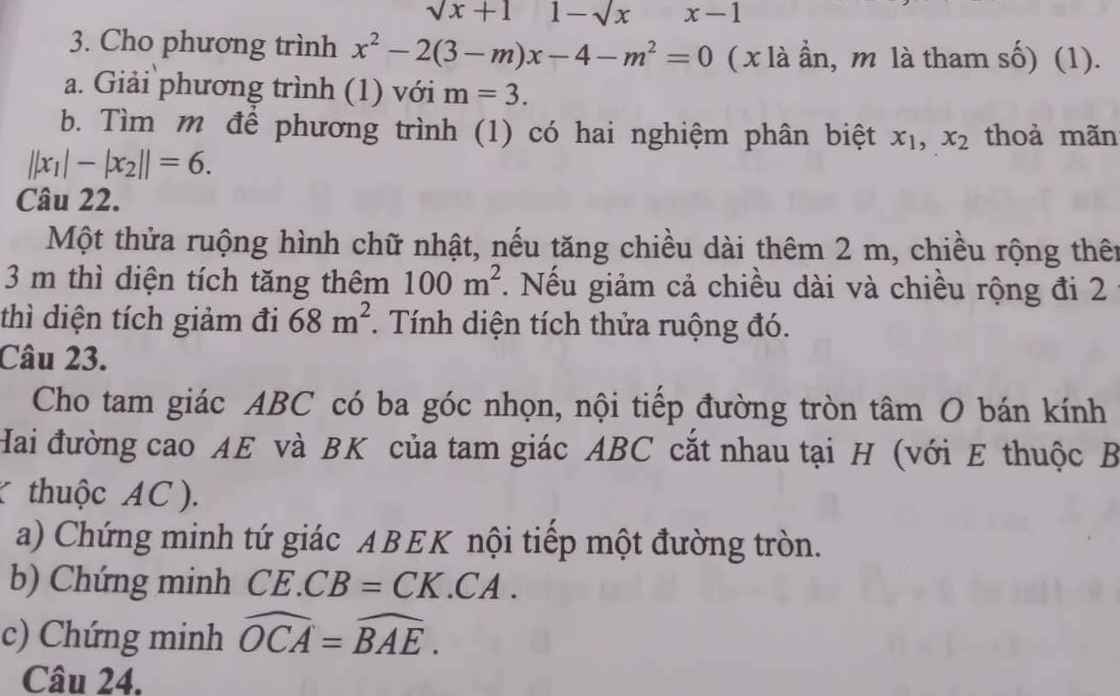Hãy nhập câu hỏi của bạn vào đây, nếu là tài khoản VIP, bạn sẽ được ưu tiên trả lời.

1.
\(a+b+c=0\) nên pt luôn có 2 nghiệm
\(\left\{{}\begin{matrix}x_1+x_2=m\\x_1x_2=m-1\end{matrix}\right.\)
\(A=\dfrac{2x_1x_2+3}{x_1^2+x_2^2+2x_1x_2+2}=\dfrac{2x_1x_2+3}{\left(x_1+x_2\right)^2+2}=\dfrac{2\left(m-1\right)+3}{m^2+2}=\dfrac{2m+1}{m^2+2}\)
\(A=\dfrac{m^2+2-\left(m^2-2m+1\right)}{m^2+2}=1-\dfrac{\left(m-1\right)^2}{m^2+2}\le1\)
Dấu "=" xảy ra khi \(m=1\)
2.
\(\Delta=m^2-4\left(m-2\right)=\left(m-2\right)^2+4>0;\forall m\) nên pt luôn có 2 nghiệm pb
Theo Viet: \(\left\{{}\begin{matrix}x_1+x_2=m\\x_1x_2=m-2\end{matrix}\right.\)
\(\dfrac{\left(x_1^2-2\right)\left(x_2^2-2\right)}{\left(x_1-1\right)\left(x_2-1\right)}=4\Rightarrow\dfrac{\left(x_1x_2\right)^2-2\left(x_1^2+x_2^2\right)+4}{x_1x_2-\left(x_1+x_2\right)+1}=4\)
\(\Rightarrow\dfrac{\left(x_1x_2\right)^2-2\left(x_1+x_2\right)^2+4x_1x_2+4}{x_1x_2-\left(x_1+x_2\right)+1}=4\)
\(\Rightarrow\dfrac{\left(m-2\right)^2-2m^2+4\left(m-2\right)+4}{m-2-m+1}=4\)
\(\Rightarrow-m^2=-4\Rightarrow m=\pm2\)

|x1|=3|x2|
=>|2m+2-x2|=|3x2|
=>4x2=2m+2 hoặc -2x2=2m+2
=>x2=1/2m+1/2 hoặc x2=-m-1
Th1: x2=1/2m+1/2
=>x1=2m+2-1/2m-1/2=3/2m+3/2
x1*x2=m^2+2m
=>1/2(m+1)*3/2(m+1)=m^2+2m
=>3/4m^2+3/2m+3/4-m^2-2m=0
=>m=1 hoặc m=-3
TH2: x2=-m-1 và x1=2m+2+m+1=3m+3
x1x2=m^2+2m
=>-3m^2-6m-3-m^2-2m=0
=>m=-1/2; m=-3/2

a: \(\text{Δ}=\left(2m+1\right)^2-4m\left(m+3\right)\)
\(=4m^2+4m+1-4m^2-12m\)
\(=-8m+1\)
Để phương trình có hai nghiệm phân biệt thì Δ>0
\(\Leftrightarrow-8m+1>0\)
\(\Leftrightarrow-8m>-1\)
hay \(m< \dfrac{1}{8}\)

a (tóm tắt lại): Phương trình hoành độ giao điểm của (P) và (d):
\(x^2=mx-m+1\)
\(\Leftrightarrow x^2-mx+m-1=0\left(1\right)\)
Để (d) cắt (P) tại 2 điểm phân biệt thì phương trình (1) phải có 2 nghiệm phân biệt. Do đó \(\Delta>0\Leftrightarrow m\ne2\).
b) \(\left(1\right)\Leftrightarrow\left(x-1\right)\left(x+1\right)-m\left(x-1\right)=0\)
\(\Leftrightarrow\left(x-1\right)\left(x-m+1\right)=0\)
\(\Leftrightarrow\left[{}\begin{matrix}x=1\\x=m-1\end{matrix}\right.\)
Do đó phương trình (1) có 2 nghiệm là x=1 và x=m-1. Mặt khác phương trình (1) cũng có 2 nghiệm phân biệt là x1, x2 và vai trò của x1, x2 trong biểu thức A là như nhau nên ta giả sử \(x_1=1;x_2=m-1\left(m\ne2\right)\)
Từ đây ta có:
\(A=\dfrac{2.1.\left(m-1\right)}{1^2+\left(m-1\right)^2+2\left[1+1.\left(m-1\right)\right]}\)
\(=\dfrac{2\left(m-1\right)}{1+\left(m-1\right)^2+2+2\left(m-1\right)}\)
\(=\dfrac{2\left(m-1\right)}{1+\left(m^2-2m+1\right)+2+2m-2}=2.\dfrac{m-1}{m^2+2}\)
\(\Rightarrow A\left(m^2+2\right)=2\left(m-1\right)\)
\(\Leftrightarrow Am^2-2m+2\left(A+1\right)=0\left(2\right)\)
Coi phương trình (2) là phương trình bậc 2 tham số A ẩn x, ta có:
\(\Delta'\left(2\right)=1^2-2A\left(A+1\right)=-2\left(A^2+A\right)+1=-2\left(A+\dfrac{1}{2}\right)^2+\dfrac{3}{2}\)
Để phương trình (2) có nghiệm thì \(\Delta'\left(2\right)\ge0\Rightarrow-2\left(A+\dfrac{1}{2}\right)^2+\dfrac{3}{2}\ge0\)
\(\Leftrightarrow\left(A+\dfrac{1}{2}\right)^2\le\dfrac{3}{4}\)
\(\Leftrightarrow-\dfrac{\sqrt{3}}{2}\le A+\dfrac{1}{2}\le\dfrac{\sqrt{3}}{2}\)
\(\Leftrightarrow-\dfrac{\sqrt{3}+1}{2}\le A\le\dfrac{\sqrt{3}-1}{2}\)
Để phương trình (2) có nghiệm kép thì: \(\Delta'\left(2\right)=0\Rightarrow m=\dfrac{1}{A}\)
\(MinA=-\dfrac{\sqrt{3}+1}{2}\Leftrightarrow\Delta'\left(2\right)=0\Leftrightarrow m=\dfrac{1}{A}\dfrac{1}{-\dfrac{\sqrt{3}+1}{2}}=1-\sqrt{3}\)
\(MaxA=\dfrac{\sqrt{3}-1}{2}\Leftrightarrow\Delta'\left(2\right)=0\Leftrightarrow m=\dfrac{1}{A}=\dfrac{1}{\dfrac{\sqrt{3}-1}{2}}=\sqrt{3}+1\)
Mình mới sửa một chút nhé.
\(\left(A+\dfrac{1}{2}\right)^2\le\dfrac{3}{4}\) \(\Leftrightarrow\left|A+\dfrac{1}{2}\right|\le\dfrac{\sqrt{3}}{2}\Leftrightarrow\left[{}\begin{matrix}A+\dfrac{1}{2}\le\dfrac{\sqrt{3}}{2}\\A+\dfrac{1}{2}\ge\dfrac{-\sqrt{3}}{2}\end{matrix}\right.\Leftrightarrow\dfrac{-\sqrt{3}}{2}\le A+\dfrac{1}{2}\le\dfrac{\sqrt{3}}{2}\)
Nếu gặp dạng \(a^2\le b\) (b là số dương) thì a sẽ bé hơn b và lớn hơn số đối của b, nói chung a nằm trong khoảng từ -b đến b.
Ví dụ: \(a^2\le4\Leftrightarrow\left|a\right|\le2\Leftrightarrow-2\le a\le2\)

Vì \(a\cdot c=1\cdot\left(-2\right)=-2< 0\)
nên phương trình luôn có hai nghiệm phân biệt
Theo Vi-et, ta có:
\(\left\{{}\begin{matrix}x_1+x_2=-\dfrac{b}{a}=m\\x_1x_2=\dfrac{c}{a}=-2\end{matrix}\right.\)
Sửa đề: \(x_1^2\cdot x_2+x_1\cdot x_2^2+7>x_1^2+x_2^2+\left(x_1+x_2\right)^2\)
=>\(x_1x_2\left(x_1+x_2\right)+7>\left(x_1+x_2\right)^2-2x_1x_2+\left(x_1+x_2\right)^2\)
=>\(-2m+7>m^2-2\left(-2\right)+m^2\)
=>\(2m^2+4< -2m+7\)
=>\(2m^2+2m-3< 0\)
=>\(\dfrac{-1-\sqrt{7}}{2}< m< \dfrac{-1+\sqrt{7}}{2}\)

\(\Delta=1-4m>0\Rightarrow m< \dfrac{1}{4}\)
Theo hệ thức Viet: \(\left\{{}\begin{matrix}x_1+x_2=1\\x_1x_2=m\end{matrix}\right.\)
\(\left(x_1^2+x_2+m\right)\left(x_2^2+x_1+m\right)=m^2-m-1\)
\(\Leftrightarrow\left[x_1\left(x_1+x_2\right)-x_1x_2+x_2+m\right]\left[x_2\left(x_1+x_2\right)-x_1x_2+x_1+m\right]=m^2-m-1\)
\(\Leftrightarrow\left(x_1+x_2\right)\left(x_1+x_2\right)=m^2-m-1\)
\(\Leftrightarrow m^2-m-1=1\)
\(\Leftrightarrow m^2-m-2=0\Rightarrow\left[{}\begin{matrix}m=-1\\m=2>\dfrac{1}{4}\left(loại\right)\end{matrix}\right.\)

\(m=0\) là okee rồi nè
còn \(x_1=x_2\) thì như sau :
\(\Leftrightarrow x_1-x_2=0\)
\(\Leftrightarrow\left(x_1-x_2\right)^2=0^2\)
\(\Leftrightarrow\left(x_1+x_2\right)^2-4x_1x_2=0\)
Tới đây rồi áp dụng cái Vi-ét vào là được m còn lại nhe.


xét pt \(x^2-mx+m-1=0\) \(\left(1\right)\)
xó \(\Delta=\left(-m\right)^2-4\left(m-1\right)=m^2-4m+4=\left(m-2\right)^2>0\forall m\ne2\)
\(\Rightarrow pt\) (1) có 2 nghiệm phân biệt \(x_1,x_2\forall m\ne2\)
ta có vi -ét \(\hept{\begin{cases}x_1+x_2=m\\x_1.x_2=m-1\end{cases}}\)
theo bài ra \(\left|x_1\right|+\left|x_2\right|=6\)
\(\Leftrightarrow\left(\left|x_1\right|+\left|x_2\right|\right)^2=36\)
\(\Leftrightarrow x_1^2+x_2^2+2\left|x_1.x_2\right|=36\)
\(\Leftrightarrow\left(x_1+x_2\right)^2-2x_1x_2+2\left|x_1x_2\right|=36\)
\(\Leftrightarrow m^2-2\left(m-1\right)+2\left|m-1\right|=36\)
nếu \(m-1< 0\Rightarrow m^2-4m-32=0\) ta tìm được \(m=8\left(loai\right)\); \(m=-4\left(TM\right)\)
nếu \(m-1\ge0\Rightarrow m^2=36\Rightarrow m=6\left(TM\right);m=-6\left(loai\right)\)
vậy \(m=-4;m=6\) là các giá trị cần tìm
b) \(P=\frac{2x_1x_2+3}{\left(x_1+x_2\right)^2-2x_1x_2+2x_1x_2+2}\)
\(P=\frac{2x_1x_2+3}{\left(x_1+x_2\right)^2+2}=\frac{2\left(m-1\right)+3}{m^2+2}\)
\(P=\frac{2m-2+3}{m^2+2}=\frac{2m+1}{m^2+2}\)
vậy \(P=\frac{2m+1}{m^2+2}\)